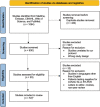Facial Nerve Paralysis and COVID-19: A Systematic Review
- PMID: 35938708
- PMCID: PMC9538897
- DOI: 10.1002/lary.30333
Facial Nerve Paralysis and COVID-19: A Systematic Review
Abstract
Objective: Several cases of facial nerve paralysis (FNP) post-COVID-19 infection have been reported with varying presentations and management. This study aims to identify FNP clinical characteristics and recovery outcomes among patients acutely infected with COVID-19. We hypothesize that FNP is a potentially unique sequalae associated with COVID-19 infections.
Methods: A systematic review of PubMed-Medline, OVID Embase, and Web of Science databases from inception to November 2021 was conducted following the Preferred Reporting Items for Systematic Reviews and Meta-Analyses guidelines.
Results: This search identified 630 studies with 53 meeting inclusion criteria. This resulted in 72 patients, of which 30 (42%) were diagnosed with Guillain-Barré Syndrome (GBS). Non-GBS patients were on average younger (36 vs. 53 years) and more likely to present with unilateral FNP (88%) compared to GBS patients who presented predominantly with bilateral FNP (74%). Among non-GBS patients, majority (70%) of FNP presented a median of 8 [IQR 10] days after the onset of initial COVID-19 symptom(s). Treatment for non-GBS patients consisted of steroids (60%), antivirals (29%), antibiotics (21%), and no treatment (21%). Complete FNP recovery in non-GBS patients was achieved in 67% patients within a median of 11 [IQR 24] days.
Conclusion: FNP is a possible presentation post COVID-19 infections, associated with both GBS and non-GBS patients. Although no causation can be assumed, the clinical course of isolated FNP associated with COVID-19 raises the possibility of a unique presentation differing from Bell's palsy, seen with higher proportion of patients developing bilateral FNP and a shorter duration to complete recovery. Laryngoscope, 133:1007-1013, 2023.
Keywords: Bell's palsy; COVID-19; facial nerve; paralysis.
© 2022 The American Laryngological, Rhinological and Otological Society, Inc.
Figures
Similar articles
-
Bilateral simultaneous facial nerve palsy: clinical analysis in seven cases.Otol Neurotol. 2008 Apr;29(3):397-400. doi: 10.1097/mao.0b013e3181656998. Otol Neurotol. 2008. PMID: 18227739
-
Irreversible facial nerve palsy as a revelator ofparotid gland cancer.Otolaryngol Pol. 2023 Sep 29;77(5):8-13. doi: 10.5604/01.3001.0053.4090. Otolaryngol Pol. 2023. PMID: 38032327
-
Facial nerve palsy in children: A retrospective study of 124 cases.J Paediatr Child Health. 2019 Mar;55(3):299-304. doi: 10.1111/jpc.14190. Epub 2018 Aug 24. J Paediatr Child Health. 2019. PMID: 30144181
-
A systematic review of Bell's Palsy as the only major neurological manifestation in COVID-19 patients.J Clin Neurosci. 2021 Aug;90:284-292. doi: 10.1016/j.jocn.2021.06.016. Epub 2021 Jun 21. J Clin Neurosci. 2021. PMID: 34275565
-
Facial Nerve Palsy Amid the SARS-CoV-2 Pandemic: A Pooled Analysis.J Otolaryngol Head Neck Surg. 2025 Jan-Dec;54:19160216251315057. doi: 10.1177/19160216251315057. J Otolaryngol Head Neck Surg. 2025. PMID: 39916377 Free PMC article.
Cited by
-
The impact of Chinese COVID-19 pandemic on the incidence of peripheral facial nerve paralysis after optimizing policies.Front Public Health. 2023 Nov 2;11:1236985. doi: 10.3389/fpubh.2023.1236985. eCollection 2023. Front Public Health. 2023. PMID: 38026328 Free PMC article.
-
Case report: Bilateral facial palsy with paresthesias and positive anti-GT1a antibodies.Front Immunol. 2024 Jun 7;15:1410634. doi: 10.3389/fimmu.2024.1410634. eCollection 2024. Front Immunol. 2024. PMID: 38911860 Free PMC article.
-
Prevalence, Etiology, Risk Factors, and Complications of Facial Nerve Palsy at King Abdulaziz Medical City: A Multicenter Study.Cureus. 2024 Feb 1;16(2):e53403. doi: 10.7759/cureus.53403. eCollection 2024 Feb. Cureus. 2024. PMID: 38435234 Free PMC article.
-
Analytical review of facial nerve palsy following SARS-CoV-2 vaccination: comprehensive assessment.Eur Arch Otorhinolaryngol. 2025 Jun;282(6):2787-2797. doi: 10.1007/s00405-024-09173-z. Epub 2025 Jan 10. Eur Arch Otorhinolaryngol. 2025. PMID: 39792199 Review.
-
The synergistic role of viral infection and immune response in the pathogenesis of facial palsy.J Neurovirol. 2025 Jun;31(3):208-218. doi: 10.1007/s13365-025-01258-7. Epub 2025 May 15. J Neurovirol. 2025. PMID: 40374879 Free PMC article. Review.
References
-
- Movérare T, Lohmander A, Hultcrantz M, Sjögreen L. Peripheral facial palsy: speech, communication and oral motor function. Eur Ann Otorhinolaryngol Head Neck Dis. 2017;134(1):27‐31. - PubMed
-
- Lorch M, Teach SJ. Facial nerve palsy: etiology and approach to diagnosis and treatment. Pediatr Emerg Care. 2010;26(10):763‐769. - PubMed
-
- Goh Y, Beh DLL, Makmur A, Somani J, Chan ACY. Pearls & Oy‐sters: facial nerve palsy in COVID‐19 infection. Neurology. 2020;95(8):364‐367. - PubMed
Publication types
MeSH terms
Substances
LinkOut - more resources
Full Text Sources
Medical


